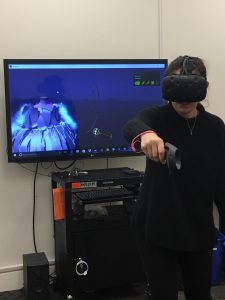This was my second experience with VR, and it largely overshadowed the first one. It was awesome! I especially enjoyed being part of this fantasy world. Being able to easily switch from one world to another was incredible…
At the very beginning it took me some time to figure out how to start the application (the lab). I didn’t know I had to approach the control to the “start” button in the podium (not sure if this is the correct name) and then pull the trigger (or press the circular button, I don’t remember which one was it). However, now that I think about this it was probably the most intuitive thing to do.
Once in the lab I wanted to visit all the different places (or experiences) available. It took me a bit to realize that the best way to move around the lab was using the teleportation option. At first I wanted to move around as I would do in real life, but as you can imagine I hit a wall and some furniture.
The first thing that caught my attention in the lab was the old tree. Once I approached it I was not sure about what I had to do, but Noura told me I should grab the sphere and bring it to my face (without her help I’m not sure whether I would have figured it out by myself) I LOVED to be inside this old cabin with magical objects (in my head I was in the house of a wizard). It was great to suddenly be in this fantasy world.
The other experience that I liked a lot was visiting the solar system. Even though I have been told and read about the relative size of the planets, it was impressive to see how small the Earth is compered to the Sun, Saturn and Jupiter. I was there! I could see it. Being able to grab the planets with my hands was a nice detail, I even put Saturn on my head! While I was interacting with the planets I couldn’t help to think that VR has a lot of potential in education.
I also liked playing with the robot-dog. Petting him, and scratching its tummy (or trying to) made me happy. I thought about my pets back in Ecuador. To be honest I didn’t think I was going to feel this kind of “connection” with a virtual entity. However, now that I reflect about this it makes me feel weird and a bit afraid.
Relate to the interaction with the dog, I think the experience could have been improved by providing some sort of haptic feedback. It was strange to pet it and feel nothing (having my hand going through it was ‘upsetting‘). Also, having a different kind of controls (like gloves) would help to make the experience more natural.
Finally, I completely agree with something that was mentioned in the article from Wired: the transition from the virtual to the real world might be difficult. I really wanted to stay in this parallel world longer. Once I took off the equipment, and realize that I was in this “boring” room, I felt disoriented and maybe even a bit sad (“I’m back to the real world”). I needed some seconds to be fully back. Although I’m well aware it might have been the excitement of the novelty, I can’t help to feel troubled. What if people actually prefer this other world? What if people get so hooked that forget about reality, and the valuable connection with real animals and people?

